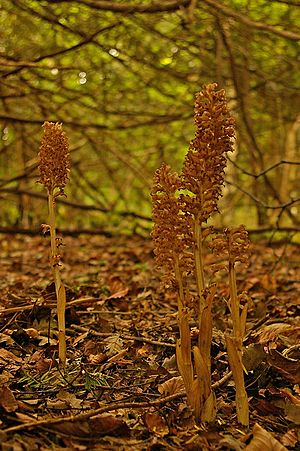Dingle Wood facts for kids
| Site of Special Scientific Interest | |

Example - Bird's Nest Orchid (Neottia nidus-avis)
|
|
| Area of Search | Gloucestershire |
|---|---|
| Coordinates | 51°48′03″N 2°38′09″W / 51.800872°N 2.635862°W |
| Interest | Biological |
| Area | 9.95 hectare |
| Notification | 1972 |
Dingle Wood is a special forest area in Gloucestershire, England. It's about 9.95 hectares big, which is like 25 football fields! Since 1972, it has been known as a Site of Special Scientific Interest (SSSI). This means it's a really important place for nature and wildlife.
Dingle Wood is also part of the beautiful Forest of Dean and the Wye Valley. The Wye Valley is a protected area known for its amazing scenery. Dingle Wood is even listed as a Key Wildlife Site because of all the cool plants and animals that live there.
Where is Dingle Wood?
The Forest of Dean, where Dingle Wood is found, has been important for growing trees for hundreds of years. People have carefully planted and looked after the woods here. This means you can find many different kinds of woodlands in the area.
The middle part of the Forest of Dean sits on old rocks from the Carboniferous period. These rocks are like coal and make the soil a bit acidic. This soil is great for Oak trees and plants that don't like lime. Around this central area, you'll find different kinds of rocks, like limestone and sandstone. These rocks create richer soil, which helps even more types of trees and plants grow.
Trees and Plants in Dingle Wood
Even though Dingle Wood was planted by people, it's considered one of the best examples of a woodland habitat. You can find many types of trees here, including Oak, Ash, Beech, some Cherry, and Rowan.
There are also many shrubs, which are smaller woody plants. These include Holly, Yew, Field Maple, and Hazel.
What Grows on the Ground?
The eastern part of Dingle Wood is covered with plants like Bramble, Bluebell, Wood Anemone, Wood Sorrel, and Ivy.
The western part of the wood is a bit different. It has bumpy ground with deep holes called Scowles. These holes are left over from old iron mining. Because of these unique conditions, you can find some rare plants here. These include Herb Paris, Common Wintergreen, Bird's Nest Orchid, and the Greater Butterfly Orchid.

